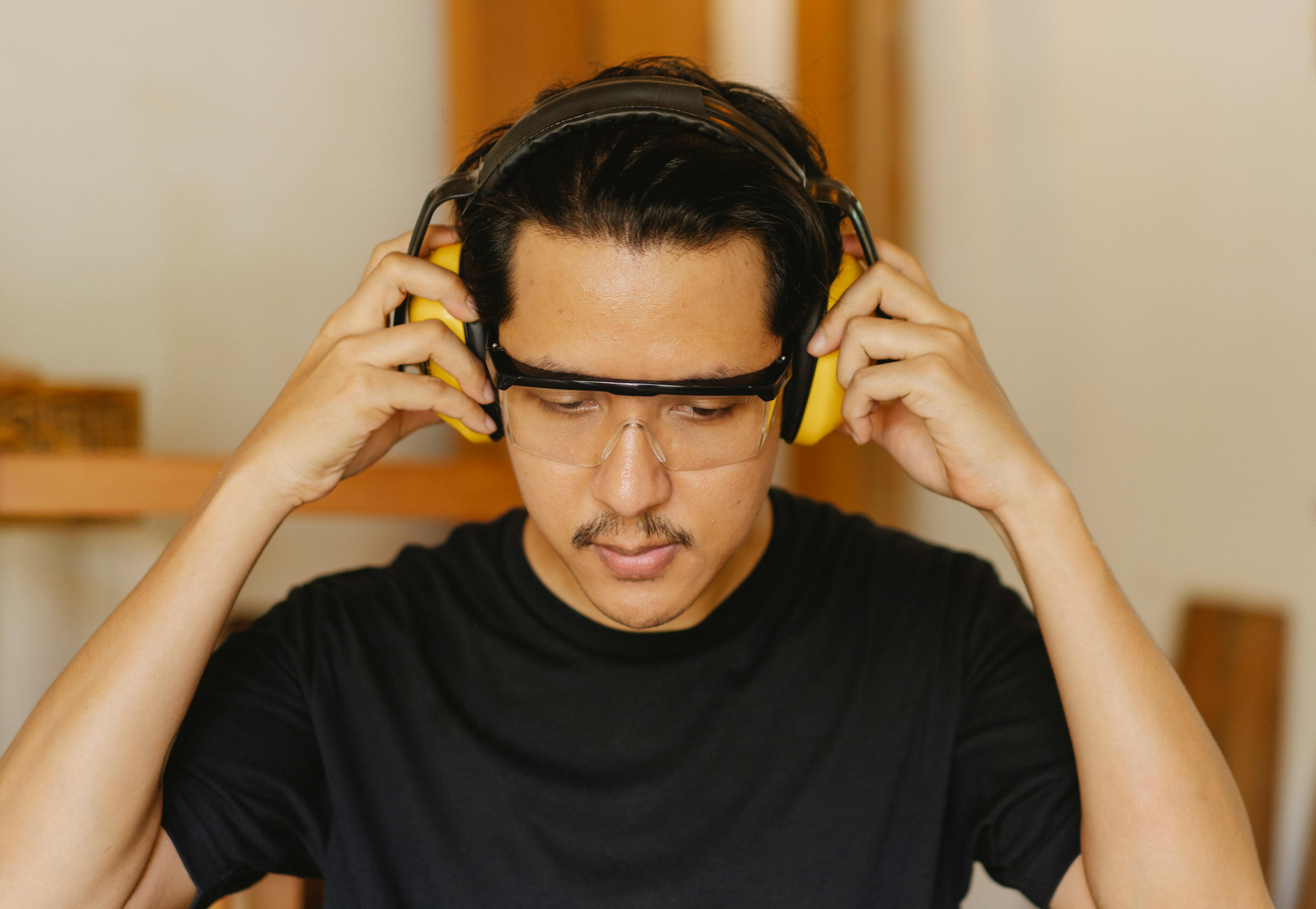How To Wear Glasses With Headphones

Wearing glasses and headphones at the same time can be a tricky task, but it doesn’t have to be. With a few simple steps, you can easily learn how to wear your glasses and headphones in comfort and style. In this article, we will provide tips on how to wear your glasses with headphones so you can enjoy your music and look great while doing it.To wear glasses with headphones, start by adjusting the glasses to fit comfortably on the bridge of your nose. Make sure that the arms of your glasses extend behind your ears and are not pressing on them. Next, place the headphones over your ears with the headband lying across the back of your head. If needed, adjust the earpieces to fit over or around your glasses. Finally, adjust the volume of your headphones accordingly and enjoy!
Choosing The Right Style of Headphones
Headphones come in many different styles, from over-ear to earbuds. It can be difficult to decide which type of headphones are best for your needs. When choosing the right style of headphones, it is important to consider how they fit on your head, the sound quality they provide, and the features they offer.
Over-ear headphones are designed to cover the entire ear and provide superior sound quality. These headphones usually have larger drivers that deliver deeper bass and clearer highs. They also offer better noise cancellation than other types of headphones, making them ideal for listening in noisy environments or while traveling. Over-ear headphones can be more expensive than other types, but if sound quality is a priority then this is the way to go.
Earbuds are the most common type of headphone and are often included with portable devices like smartphones and MP3 players. They fit directly into the ear canal and provide decent sound quality for their small size. Earbuds are lightweight and portable, making them great for use on the go. However, they may not provide as much noise cancellation as other types of headphones and may not be as comfortable after extended periods of use.
In-ear monitors (IEMs) are similar to earbuds but fit directly into the ear canal and form a seal that blocks out external noise while delivering clear audio. IEMs typically have a higher price tag than other types of headphones but offer superior sound quality and noise isolation in a compact package. They are ideal for music producers or audiophiles who want the best possible audio experience without sacrificing comfort or portability.
When choosing the right style of headphones it is important to consider how they will fit on your head, what kind of sound quality they offer, and what features they have available. With so many options available it’s easy to find a pair that meets your needs without breaking the bank!
Considering Comfort When Wearing Glasses with Headphones
When wearing glasses and headphones, comfort is of the utmost importance. It is important to make sure that the glasses fit properly and that the frames are not too tight or too loose. It is also essential to ensure that the headphones fit comfortably over the ears and do not cause any discomfort or irritation. Additionally, it is important to consider any additional padding around the ears or headband to reduce pressure points when wearing glasses with headphones.
Furthermore, when wearing glasses with headphones it can be beneficial to adjust the nose pads on your glasses for maximum comfort. This will help reduce pressure points and make it easier to wear your glasses for long periods of time without discomfort. Additionally, ensuring that your glasses are clean and free from smudges or other debris can help improve comfort levels when wearing them with headphones.
Finally, it is important to consider what type of material your headphones are made from as this will affect how comfortable they are when worn with glasses. Soft leather or foam-filled earpads can provide extra cushioning which helps reduce pressure points on your ears and head when wearing them with glasses. Additionally, opting for adjustable headbands can be beneficial as this allows you to customize the fit of your headphones for maximum comfort while wearing glasses.
Adjusting Your Glasses To Fit With Headphones
It can be a challenge to wear headphones with glasses, but it doesn’t have to be. With a few simple adjustments, you can make sure your glasses fit comfortably and securely with your headphones.
First, make sure your headphones are the right size and fit for your head. If they are too big or too small, they won’t fit properly over your glasses. You may want to consider investing in a pair of custom-fitted headphones that will fit your head and glasses perfectly.
Next, adjust the earcups of your headphones so that they sit firmly but comfortably on top of your ears and around the frame of your glasses. If the earcups are pressing too hard against the frame of your glasses, try adjusting the headband for a looser fit.
If the headband is already loose enough but you’re still feeling discomfort, you may need to adjust the angle of your glasses on your face. To do this, simply use both hands to push down on each side of the frame while gently tilting them forward or backward until it feels comfortable for you.
Finally, if you’re still having trouble finding a comfortable fit with your glasses and headphones, consider adding some padding or cushioning between them. This can help reduce any pressure points that may be causing discomfort when wearing them together.
Overall, it takes some trial and error to find the perfect combination of headset size, earcup adjustment and frame angle that works for you – but it’s well worth it in order for you to enjoy an uninterrupted listening experience with both comfort and style!
Checking For Pressure Points When Wearing Glasses and Headphones Together
Wearing glasses and headphones together can be a challenge. It is important to check for pressure points that can cause discomfort and even pain. Pressure points are areas of concentrated pressure that can be caused by the glasses arms or the headphone band pressing against your head. To avoid any discomfort, it is important to make sure that the glasses arms and headphone band are not pressing too hard against your head.
The best way to check for pressure points is to use your fingers to gently press around the headset and glasses arms. If you feel any tightness or pressure, move the glasses down slightly until it feels comfortable. Doing this will avoid any possible discomfort or pain while wearing both items at the same time.
It is also important to make sure that your ears are properly covered when wearing headphones with glasses. This will help ensure that they are not putting any extra pressure on your ears when they are underneath the headphones. If you find that your ears are not completely covered, you may need to adjust the size of your headset or look for a larger pair of headphones to ensure a comfortable fit.
Finally, if possible, try wearing your glasses and headphones together in a mirror before wearing them out in public. This will help you see if there are any areas of uncomfortable pressure and make adjustments before leaving home. With a little bit of trial and error, you should be able to find a combination that fits comfortably without causing any pain or discomfort.

Ensuring Your Ears Remain Protected When Wearing Both
Protecting your ears from potential harm is extremely important, especially when wearing both earbuds and headphones. In this article, you will learn the importance of ear protection and how to ensure that your ears remain safe when using both devices. You will also learn the different types of ear protectors available and the best ways to care for your ears while using them.
When using both earbuds and headphones, it is important to be aware of the risks associated with prolonged exposure to loud music or other sounds. Exposure to loud noise can cause permanent hearing damage over time, so it is essential that you take precautions to protect your ears. Using earplugs or ear defenders can help reduce the risk of hearing loss by blocking out loud noises and reducing the intensity of sound waves as they enter your ears.
When selecting an appropriate pair of earplugs or ear defenders, make sure that they fit snugly in your ears and that they are comfortable to wear for long periods of time. It is also important to choose a pair that will not interfere with the sound quality of your music or other audio content. If you are using both headphones and earbuds for extended periods, it is best to select a pair with a low profile so as not to interfere with either device’s fit or sound quality.
It is also essential to take proper care of your ears when wearing both devices. Make sure that you clean them regularly with soft cloths or wipes, since dirt and debris can accumulate in any area where moisture resides. Additionally, it is important to avoid excessive exposure to loud noises by turning down the volume on your device and taking regular breaks from listening if necessary. Finally, check with a medical professional if you notice any signs of hearing problems such as ringing in your ears or difficulty understanding conversations in noisy environments.
By following these simple steps, you can ensure that your ears remain healthy while using both headphones and earbuds. Taking care of your hearing health is essential for enjoying music and audio content safely over time, so be sure to take proper precautions when listening on both devices!
Listening For Signs Of Discomfort When Wearing Both Glasses and Headphones
When wearing both glasses and headphones, it is important to be aware of any signs of discomfort. Headphones can put pressure on the temples and can cause headaches if worn for too long. Similarly, glasses can cause the bridge of the nose to become sore after a period of time. In order to prevent any unpleasantness or pain while wearing both glasses and headphones, it is important to listen for signs of discomfort.
If you begin to feel any pain or pressure around your temples or bridge of your nose, take a break from wearing both glasses and headphones. Taking a break will allow your skin to adjust and any soreness or tension should go away. If the discomfort persists, it may be necessary to adjust either the fit of your glasses or the fit of your headphones in order to make them more comfortable.
It is also important to be mindful about how often you are wearing both glasses and headphones at once. Even if they are comfortable at first, extended periods of time with them on can cause discomfort due to their weight and pressure on various parts of your face. Therefore, it is best practice to take regular breaks from wearing both glasses and headphones in order to prevent any long-term pain or irritation.
By listening for signs of discomfort when wearing both glasses and headphones, you can ensure that you are able to wear them comfortably for extended periods of time without causing any harm or irritation. Paying attention to how you feel while wearing them will help you recognize when it is time for a break in order maintain comfortability while still enjoying music or videos with sound quality.
Can I Wear Glasses Comfortably While Using Skullcandy Jib True Wireless Earbuds?
Wearing glasses while using Skullcandy Jib True Wireless Earbuds can be comfortable with the right adjustments. Consider these skullcandy earbuds styling tips: choose smaller frames, ensure a secure fit, and position the earbuds for minimal interference. This way, you can enjoy music without sacrificing comfort or style.
Taking Regular Breaks From Both The Glasses And The Headphones
It is important to take regular breaks from both the glasses and the headphones. Wearing glasses or headphones for too long can cause discomfort, fatigue, and even headaches in some people. This is why it is important to take regular breaks to avoid any potential health problems.
Taking breaks from wearing glasses or headphones for a few minutes every hour can help reduce any strain on your eyes or ears. It also gives your eyes and ears a chance to rest and recover, which can help prevent any long-term damage. When you take a break, try looking away from the screen or taking the headphones off for a few minutes to give your eyes and ears a break.
It is also important to adjust the settings on your glasses or headphones if needed. For instance, if you wear glasses, make sure that they are not too tight so that they don’t cause any discomfort when worn for extended periods of time. Similarly, if you are using headphones, make sure that the volume isn’t too high so that it doesn’t damage your hearing over time.
Taking regular breaks from wearing glasses or headphones can help ensure that you remain comfortable while using them and minimize any potential health risks associated with extended use of either device. Be sure to pay attention to how you feel while wearing glasses or headphones and take breaks when needed to ensure comfortable use over time.

Conclusion
Wearing glasses with headphones is a great way to make sure your eyewear is comfortable and secure. It’s important to ensure your glasses are the right size and shape for your headphones, as well as that they fit securely onto your ears and don’t cause any discomfort. Along with this, you should also be sure to clean and maintain your frames and lenses regularly. This will help to ensure that they remain in the best condition possible. Lastly, when wearing glasses with headphones, it’s important to be aware of the potential risks of doing so, such as hearing loss or damage caused by prolonged use.
Overall, wearing glasses with headphones can be a great way to keep your eyewear secure and comfortable while listening to music or engaging in other activities. By following the tips outlined in this article, you’ll be able to successfully wear glasses with headphones without any discomfort or risk of damage.
